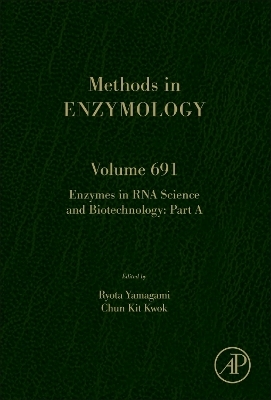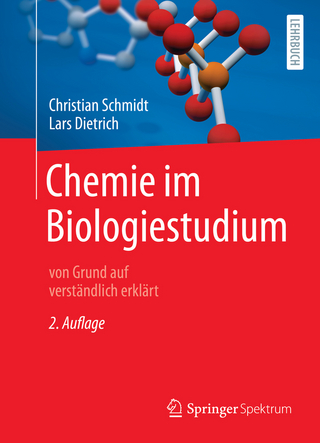
Enzymes in RNA Science and Biotechnology
Academic Press Inc (Verlag)
978-0-443-15770-7 (ISBN)
Dr. Chun Kit Kwok obtained his B.Sc. in Chemistry (2009) from the Chinese University of Hong Kong, after completing an exchange program at University of California, Los Angeles in 2007-2008. He completed his PhD in Pennsylvania State University (2014), mentored by Professor Philip C. Bevilacqua and Professor Sarah M. Assmann. In Apr 2014, Dr. Kwok worked as a Croucher Postdoctoral Fellow in University of Cambridge under Professor Sir Shankar Balasubramanian. In Oct 2016, Dr. Kwok's joined the City University of Hong Kong as an Assistant professor and has been promoted to Associate professor in July 2021. In 2019, he was one of the recipients of the CityU President Award and Croucher Innovation Award. In 2020, Dr. Kwok's joined the State Key Laboratory of Marine Pollution, City University of Hong Kong. In 2021, Dr. Kwok was recognized as elected member of Hong Kong Young Academy of Science (YASHK) and Hong Kong Institute for Advanced Study Rising Star in Chemistry. In 2022, Dr. Kwok was awarded the NSFC Excellent Young Scientist Fund. Dr. Kwok’s current research focus is to explore the role of RNA structures and interactions in biology, especially the functions of G-quadruplex structures/interactions and non-coding RNA structures/interactions in the mammalian transcriptome and their relevance to gene regulation, RNA metabolism and diseases. Two new research directions in the Kwok lab are to develop targeting tools for detection, imaging, intervention of these important RNA structures and interactions, as well as to invent innovative nucleic acid-based technologies for sensing chemical pollutants and pathogens Prof. Ryota Yamagami received his Ph.D degree under the supervision of Prof. Hori at Ehime University in Japan in 2015 where he studied folate-dependent tRNA methyltransferase and tRNA modification network in Thermus thermophilus, a thermophilic bacterium. After his Ph.D course, he had worked in the lab for 1 year as a JSPS postdoctral fellow. He then joined the Bevilacqua Lab at Pennsylvania State University as a postdoctal fellow in 2016 where he has studied RNA folding.
Reverse transcriptase Part I (discovery, preparation, general utilization)1. MarathonRT for routine RT-PCR and for cDNA synthesis on challenging RNA templates Structured RNAs, repeat RNAs and more2. Engineering TNA Polymerases Through Iterative Cycles of Directed EvolutionReverse transcriptase Part II (RNA structure mapping and determination)3. RNA G-quadruplex (rG4) structure detection using RTS and SHALiPE assays4. tRNA Structure-seq in vivo and in droplets5. Capture the in vivo intact RNA structurome by CAP-STRUCTURE-seq6. Sequencing-based analysis of RNA structures in living cells with SHAPE-MaPRNA polymerase (discovery, preparation, development/engineering and application)7. Making RNA: Using T7RNA polymerase to produce high yields of RNA from DNA templates8. A Simple Approach to Improving RNA Synthesis: Salt Inhibition of RNA Rebinding Coupled with Strengthening Promoter Binding by a Targeted Gap in the DNA9. Isolation of E. coli RNA polymerase transcription elongation complexes by selective photoreversible solid-phase immobilizationRNA ligase10. RNA ligation using vaccinia RNA ligase enzyme: high yield RNA coupling for RNA circularization, adapter ligation and other applications11. Chemical crosslinking and ligation methods for in vivo analysis of RNA structures and interactionsPost-transcriptional modification enzymes 12. Genome-wide detection of dihydrouridine modifications in RNA13. BID-seq: The quantitative base-resolution method for pseudouridines in mammalian mRNA.14. Quantitative DAMM-seq maps multiple RNA methylations in tRNA and mitochondrial dsRNA15. Discovering RNA modification enzymes by a comparative genomics approach16. Functional analysis of tRNA modification enzymes using Mutational profiling17. Fluorescent labelling of tRNA for interaction studies with RNA modification enzymes18. Synthesis of long RNA with a site-specific modification by enzymatic splint ligationEndo/Exo nucleases 19. Characterizing RNase L-mediated mRNA decay in single cells20. Characterization of RNase J21. DICER cleavage assays22. 23. DROSHA cleavage assays
| Erscheinungsdatum | 03.11.2023 |
|---|---|
| Reihe/Serie | Methods in Enzymology |
| Verlagsort | San Diego |
| Sprache | englisch |
| Maße | 152 x 229 mm |
| Gewicht | 610 g |
| Themenwelt | Naturwissenschaften ► Biologie ► Biochemie |
| Naturwissenschaften ► Biologie ► Genetik / Molekularbiologie | |
| ISBN-10 | 0-443-15770-7 / 0443157707 |
| ISBN-13 | 978-0-443-15770-7 / 9780443157707 |
| Zustand | Neuware |
| Informationen gemäß Produktsicherheitsverordnung (GPSR) | |
| Haben Sie eine Frage zum Produkt? |
aus dem Bereich


